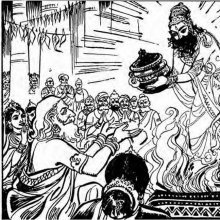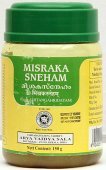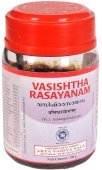Payasa, Pāyasa, Pāyāsa: 19 definitions
Introduction:
Payasa means something in Buddhism, Pali, Hinduism, Sanskrit, Marathi, Jainism, Prakrit. If you want to know the exact meaning, history, etymology or English translation of this term then check out the descriptions on this page. Add your comment or reference to a book if you want to contribute to this summary article.
Images (photo gallery)
In Hinduism
Natyashastra (theatrics and dramaturgy)
Source: Wisdom Library: Nāṭya-śāstraPāyasa (पायस) is a Sanskrit word referring to rice cooked in milk with sugar. During the ceremony of “laying the foundation” of the playhouse (nāṭyamaṇḍapa), this pāyasa should be offered to Brahmins, according to the Nāṭyaśāstra 2.41-42.

Natyashastra (नाट्यशास्त्र, nāṭyaśāstra) refers to both the ancient Indian tradition (shastra) of performing arts, (natya—theatrics, drama, dance, music), as well as the name of a Sanskrit work dealing with these subjects. It also teaches the rules for composing Dramatic plays (nataka), construction and performance of Theater, and Poetic works (kavya).
Ayurveda (science of life)
Dietetics and Culinary Art (such as household cooking)
Source: Shodhganga: Dietetics and culinary art in ancient and medieval IndiaPāyasa (पायस) refers to one of the various types of “gruels” (usually refers to a food preparation with cereal boiled in water or milk), as mentioned in the Kṛtānnavarga, which is a subsection of the Annapānavidhi of the Sūtrasthāna of the Suśrutasaṃhitā, an important Ayurvedic treatise. The discourses of the teacher Divodasa are believed to be summarised by his disciple Suśruta, who wrote the work Suśrutasaṃhitā in 4th century CE. [...] Kṛtānna-varga, the subsection of Annapānavidhi describes the preparations and properties of different types of gruels like peya, vilepi, maṇḍa, pāyasa, mudgayūṣa and kṛsara, meat dishes like ullupta, vesavāra, etc.
Pāyasa (a mixture of cooked rice, jaggery and milk) is mentioned in a list of forbidden combinations (saṃyogaviruddha) according to the 17th century Bhojanakutūhala in the dravyaguṇāguṇa-kathana, which contains the discussions on different food articles and their dietetic effects according to the prominent Ayurvedic treatises.—It is unhealthy to consume a mixture of pāyasa (a mixture of cooked rice, jaggery and milk), liquor and kṛsara (a mixture of cooked rice, salt, wet ginger, asafoetida and split red lentil).
Pāyasa is also mentioned in a list of potential causes for indigestion.—A complete section in Bhojanakutūhala is devoted for the description of agents that cause indigestion [viz., pāyasa (a mixture of cooked rice, jaggery and milk)]. These agents consumed on a large scale can cause indigestion for certain people. The remedies [viz., yūṣa prepared from green-gram] for these types of indigestions are also explained therewith.

Āyurveda (आयुर्वेद, ayurveda) is a branch of Indian science dealing with medicine, herbalism, taxology, anatomy, surgery, alchemy and related topics. Traditional practice of Āyurveda in ancient India dates back to at least the first millenium BC. Literature is commonly written in Sanskrit using various poetic metres.
Jyotisha (astronomy and astrology)
Source: Google Books: Studies in the History of the Exact Sciences (Astronomy)Pāyasa (पायस) refers to “milk-rice” (viz., rice cooked in milk) and represents one of the items offered to the nine planets (navagraha), according to the grahaśānti (cf. grahayajña) section of the Yājñavalkyasmṛti (1.295-309), preceded by the section called vināyakakalpa (1.271-294), prescribing a rite to be offered to Vināyaka.—[verse 302-303: Faggots to be burned]—These two verses prescribe different faggots [i.e., pāyasa] to be burned for grahas with offerings of honey, ghee, dadhi, and milk. It is interesting to note that some of the faggots (i.e. parāśa, khadira, pippala, and śamī) mentioned here are also used in the Suśrutasaṃhitā in the context (Uttaratantra chapters 27-37) of curing the diseases caused by grahas, which, in this case, are not planetary. [verse 304-305: Cooked rice (odana) to be offered to grahas]

Jyotisha (ज्योतिष, jyotiṣa or jyotish) refers to ‘astronomy’ or “Vedic astrology” and represents the fifth of the six Vedangas (additional sciences to be studied along with the Vedas). Jyotisha concerns itself with the study and prediction of the movements of celestial bodies, in order to calculate the auspicious time for rituals and ceremonies.
Purana and Itihasa (epic history)
Source: archive.org: Shiva Purana - English Translation1) Pāyasa (पायस) refers to “(offerings of) puddings”, according to the Śivapurāṇa 2.3.5.—Accordingly, as Brahmā narrated to Nārada the birth of Menā’s daughter:—“[...] The beloved of the mountain worshipped the Goddess along with Śiva, joyously. She gave charitable gifts always to the brahmins for their satisfaction. Desirous of obtaining a child, she worshipped Śivā everyday for twenty-seven years beginning it in the month of March-April. Observing a fast on the eighth day of the lunar fortnight, she made charitable gifts of sweets, offerings of oblation rice cakes, puddings [i.e., pāyasa] and fragrant flowers on the ninth day. [...]”.
2) Payasa (पयस) refers to the “watery places”, according to the Śivapurāṇa 2.3.38 (“Description of the dais or maṇḍapa”).—Accordingly, as Himavat prepared the wedding of Menā and Śiva: “[...] The watery places (payasa) presented there excelled the solid grounds. Even experts could not distinguish what was water and what was solid ground. There were artificial lions. There were rows of storks. There were artificial peacocks, but very beautiful in appearance. Artificial women were represented as dancing with artificial men casting wistful glances at them and enchanting them. [...]”.

The Purana (पुराण, purāṇas) refers to Sanskrit literature preserving ancient India’s vast cultural history, including historical legends, religious ceremonies, various arts and sciences. The eighteen mahapuranas total over 400,000 shlokas (metrical couplets) and date to at least several centuries BCE.
Shaivism (Shaiva philosophy)
Source: SOAS University of London: Protective Rites in the Netra TantraPāyasa (पायस) refers to “rice boiled in milk”, according to the Netratantra of Kṣemarāja: a Śaiva text from the 9th century in which Śiva (Bhairava) teaches Pārvatī topics such as metaphysics, cosmology, and soteriology.—Accordingly, [verse 19.94cd-99ab, while describing the ritual that protect the king and his kingdom]—“Then [the Mantrin] should venerate the water pot in order to protect the sleeping king. [The water pot is] made of silver and contains herbs, smeared with sandalwood and aloewood, filled with milk and water. He should worship Mṛtyujit with an all-white offering, with rice boiled in milk (pāyasa), guest water, incense, and flowers. [...]”.

Shaiva (शैव, śaiva) or Shaivism (śaivism) represents a tradition of Hinduism worshiping Shiva as the supreme being. Closely related to Shaktism, Shaiva literature includes a range of scriptures, including Tantras, while the root of this tradition may be traced back to the ancient Vedas.
In Buddhism
Mahayana (major branch of Buddhism)
Source: Wisdom Library: Maha Prajnaparamita SastraPāyasa (पायस) refers to “milk-soup” according to the according to the 2nd century Mahāprajñāpāramitāśāstra (chapter VI). The messenger came back to tell the king (Śuddhodana): “The Bodhisattva is nothing but skin, bones and sinews to hold it all together. He is very weak. Today or tomorrow will be the end of him”. But the bodhisattva, renouncing asceticism, partook of the milk soup (pāyasa) of a hundred flavors, and his body recovered its strength.
According to the 2nd century Mahāprajñāpāramitāśāstra (chapter VII), “At midnight, he left his home (abhiniṣkramaṇa) and practiced asceticism (duṣkaracarya) for six years. Then he ate some sweetened milk-broth (pāyasa) of sixteen restorative qualities offered to him by the Brāhmanī Nant’o (Nandā) and, under the tree of enlightenment (bodhivṛkṣa), he defied Māra’s army of 18,000 koṭis of warriors and attained supreme perfect enlightenment (anuttara-samyaksaṃbodhi)”.
Source: De Gruyter: A Buddhist Ritual Manual on AgriculturePāyasa (पायस) refers to “rice”, according to the 2nd-century Meghasūtra (“Cloud Sutra”) in those passages which contain ritual instructions.—Accordingly, “He who desires a mighty rain must perform this rite ‘the great-cloud-circle’ in an open space, overspread by a blue canopy, shaded by a blue banner, on a clear spot of earth; [...] Even the sea may overflow its shore, but his auspicious word ‘Rain’ fails not; nay, he must sustain himself on the three sweets, ghee, honey and sugar, and by rice (pāyasa), sugar, milk, etc., joined with all virtues of character, and repeat this; so it must needs be effectual, according to the word of the Lord of Speakers. [...]”.

Mahayana (महायान, mahāyāna) is a major branch of Buddhism focusing on the path of a Bodhisattva (spiritual aspirants/ enlightened beings). Extant literature is vast and primarely composed in the Sanskrit language. There are many sūtras of which some of the earliest are the various Prajñāpāramitā sūtras.
Languages of India and abroad
Pali-English dictionary
Source: Sutta: The Pali Text Society's Pali-English DictionaryPāyāsa, (cp. Class. Sk. pāyāsa) rice boiled in milk, milk-rice, rice porridge S. I, 166; Sn. p. 15; J. I, 50, 68; IV, 391; V, 211; Vism. 41; SnA 151; DhA. I, 171; II, 88; VvA. 32. (Page 454)
— or —
Pāyāsa, (cp. Class. Sk. pāyāsa) rice boiled in milk, milk-rice, rice porridge S. I, 166; Sn. p. 15; J. I, 50, 68; IV, 391; V, 211; Vism. 41; SnA 151; DhA. I, 171; II, 88; VvA. 32. (Page 454)

Pali is the language of the Tipiṭaka, which is the sacred canon of Theravāda Buddhism and contains much of the Buddha’s speech. Closeley related to Sanskrit, both languages are used interchangeably between religions.
Marathi-English dictionary
Source: DDSA: The Molesworth Marathi and English Dictionarypāyasa (पायस).—n S A dish made of rice, milk, and sugar.
Marathi is an Indo-European language having over 70 million native speakers people in (predominantly) Maharashtra India. Marathi, like many other Indo-Aryan languages, evolved from early forms of Prakrit, which itself is a subset of Sanskrit, one of the most ancient languages of the world.
Sanskrit dictionary
Source: Cologne Digital Sanskrit Dictionaries: Shabda-Sagara Sanskrit-English DictionaryPayasa (पयस).—n.
(-saṃ) 1. Water. 2. Milk. E. payas the same, ac added.
--- OR ---
Pāyasa (पायस).—mfn.
(-saḥ-sī-saṃ) Made of or from milk or water. mn.
(-saḥ-saṃ) 1. An oblation of milk, rice, and sugar. 2. Turpentine. n.
(-saṃ) Milk. E. payas milk or water, aff. aṇ.
Source: Cologne Digital Sanskrit Dictionaries: Benfey Sanskrit-English DictionaryPāyasa (पायस).—i. e. payas + a, I. adj. Made of milk. Ii. m. and n. Food made of milk, [Mānavadharmaśāstra] 3, 271.
Source: Cologne Digital Sanskrit Dictionaries: Cappeller Sanskrit-English DictionaryPāyasa (पायस).—[adjective] prepared with milk; [masculine] [neuter] such a food, [especially] rice boiled in milk.
Source: Cologne Digital Sanskrit Dictionaries: Monier-Williams Sanskrit-English Dictionary1) Payasa (पयस):—[from paya] mfn. full of juice or sap, [Atharva-veda] (corrupted [from] vāyasa?)
2) [v.s. ...] n. water, [cf. Lexicographers, esp. such as amarasiṃha, halāyudha, hemacandra, etc.]
3) Pāyasa (पायस):—mf(ī)n. ([from] payas) prepared with or made of milk, [Gṛhya-sūtra and śrauta-sūtra]
4) m. n. food prepared with m°, ([especially]) rice boiled in m° or an oblation of m° and rice and sugar, [ib.; Manu-smṛti; Mahābhārata] etc.
5) m. the resin of Pinus Longifolia, [cf. Lexicographers, esp. such as amarasiṃha, halāyudha, hemacandra, etc.]
Source: Cologne Digital Sanskrit Dictionaries: Yates Sanskrit-English Dictionary1) Payasa (पयस):—(saṃ) 1. n. Idem.
2) Pāyasa (पायस):—[(saḥ-saṃ)] 1. m. n. An oblation of milk, rice and sugar; turpentine. a. Made of milk or water.
Source: DDSA: Paia-sadda-mahannavo; a comprehensive Prakrit Hindi dictionary (S)Pāyasa (पायस) in the Sanskrit language is related to the Prakrit word: Pāyasa.
[Sanskrit to German]
Sanskrit, also spelled संस्कृतम् (saṃskṛtam), is an ancient language of India commonly seen as the grandmother of the Indo-European language family (even English!). Closely allied with Prakrit and Pali, Sanskrit is more exhaustive in both grammar and terms and has the most extensive collection of literature in the world, greatly surpassing its sister-languages Greek and Latin.
Prakrit-English dictionary
Source: DDSA: Paia-sadda-mahannavo; a comprehensive Prakrit Hindi dictionary1) Payāsa (पयास) in the Prakrit language is related to the Sanskrit word: Prakāśa.
2) Payāsa (पयास) also relates to the Sanskrit word: Prayāsa.
3) Pāyasa (पायस) also relates to the Sanskrit word: Pāyasa.
Prakrit is an ancient language closely associated with both Pali and Sanskrit. Jain literature is often composed in this language or sub-dialects, such as the Agamas and their commentaries which are written in Ardhamagadhi and Maharashtri Prakrit. The earliest extant texts can be dated to as early as the 4th century BCE although core portions might be older.
Kannada-English dictionary
Source: Alar: Kannada-English corpusPāyasa (ಪಾಯಸ):—
1) [noun] a kind of sweet, usu. liquid, dish made of milk, rice, sugar, etc.
2) [noun] the resin of the tree Pinus longifolia.
Kannada is a Dravidian language (as opposed to the Indo-European language family) mainly spoken in the southwestern region of India.
See also (Relevant definitions)
Starts with: Payacam, Payasadagdha, Payasadayaka, Payasaga, Payasamkale, Payasana, Payasanna, Payasapindaraka, Payasapupa, Payasaya, Payaseccha.
Ends with: Alpayasa, Anupayasa, Apayasha, Dugdhapayasa, Ghritapayasa, Halupayasa, Khirapayasa, Kodhupayasa, Nirupayasa, Ppayasa, Sopayasa, Upayasa, Yashaapayasha.
Full-text (+94): Payasika, Payasapindaraka, Prayasa, Prakasha, Tirukkannamutu, Payasadagdha, Tiru-kanamutam, Pushp, Payacam, Cemappayacam, Kannamutu, Kannalamutu, Vyala, Payaseccha, Payasapupa, Prathaman, Prakartavya, Krisara, Gomayapayasiya, Ugurottu.
Relevant text
Search found 38 books and stories containing Payasa, Pāyasa, Pāyāsa, Payāsa; (plurals include: Payasas, Pāyasas, Pāyāsas, Payāsas). You can also click to the full overview containing English textual excerpts. Below are direct links for the most relevant articles:
Rudra-Shiva concept (Study) (by Maumita Bhattacharjee)
4a. Rudra in the Pṛṣātaka ceremony < [Chapter 4 - Rudra-Śiva in the Post-Brāhmaṇic Literature]
Rig Veda (translation and commentary) (by H. H. Wilson)
Expiatory Rites in Keralite Tantra (by T. S. Syamkumar)
1.4. Expiatory Rites in Viṣṇusaṃhitā < [Chapter 3 - Expiatory Rites in Kerala Tantric Ritual Manuals]
4. Ritual Gift as a Mode of Expiation < [Chapter 4 - Socio-Cultural aspects of Expiatory Rites]
2. Expiatory Rites in Tantrasamuccaya < [Chapter 3 - Expiatory Rites in Kerala Tantric Ritual Manuals]
The Agni Purana (by N. Gangadharan)
Chapter 365 - Words relating to the class of brahmins (brahma-varga)
Chapter 168 - Kinds of Major Sins (mahāpātaka)
Khadira-grihya-sutra (by Hermann Oldenberg)
Sushruta Samhita, Volume 6: Uttara-tantra (by Kaviraj Kunja Lal Bhishagratna)
Chapter LIII - Symptoms and Treatment of Hoarseness (Svara-bheda) < [Canto III - Kaya-chikitsa-tantra (internal medicine)]
Chapter XXXV - Treatment of an attack by Mukha-mandika < [Canto II - Kaumarabhritya-tantra (pediatrics, gynecology and pregnancy)]
Chapter LX - Symptoms and Treatment of demonology (Amanusha) < [Canto IV - Bhuta-vidya-tantra (psychology and psychiatry)]
Related products


